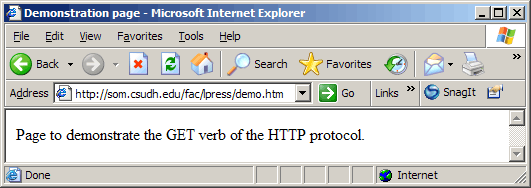
I typed in the URL, then hit the enter key. At that point, the Web client running on my computer opened a connection to Port 80 on som.csudh.edu. The Web server was listening on Port 80, so once the connection was opened, subsequent commands were passed to that program.
Next, my Web client sent the following GET command to the Web server:
The Web server returned this:GET /fac/lpress/demo.htm HTTP/1.1 Accept: image/gif, image/x-xbitmap, image/jpeg, image/pjpeg, application/vnd.ms-powerpoint, application/vnd.ms-excel, application/msword, application/x-shockwave-flash, */* Accept-Language: en-us Accept-Encoding: gzip, deflate User-Agent: Mozilla/4.0 (compatible; MSIE 6.0; Windows NT 5.1; MathPlayer 2.0; SV1; .NET CLR 1.0.3705; .NET CLR 1.1.4322) Host: som.csudh.edu Connection: Keep-Alive
At this point, the Web client program formatted the HTML it received, displayed it on the screen, and closed the connection to the server.HTTP/1.1 200 OK Content-Length: 142 Content-Type: text/html Last-Modified: Fri, 01 Jul 2005 06:25:24 GMT Accept-Ranges: bytes ETag: "10041aa57ec51:1c3f" Server: Microsoft-IIS/6.0 MicrosoftOfficeWebServer: 5.0_Pub Date: Fri, 01 Jul 2005 06:50:19 GMT <html> <head> <title>Demonstration page</title> </head> <body> Page to demonstrate the GET verb of the HTTP protocol. </body> </html>
I logged two other HTTP requests, one to retrieve the home page at Google and the second Ford.
I captured all three logs using a sniffer program called HTTPLook.